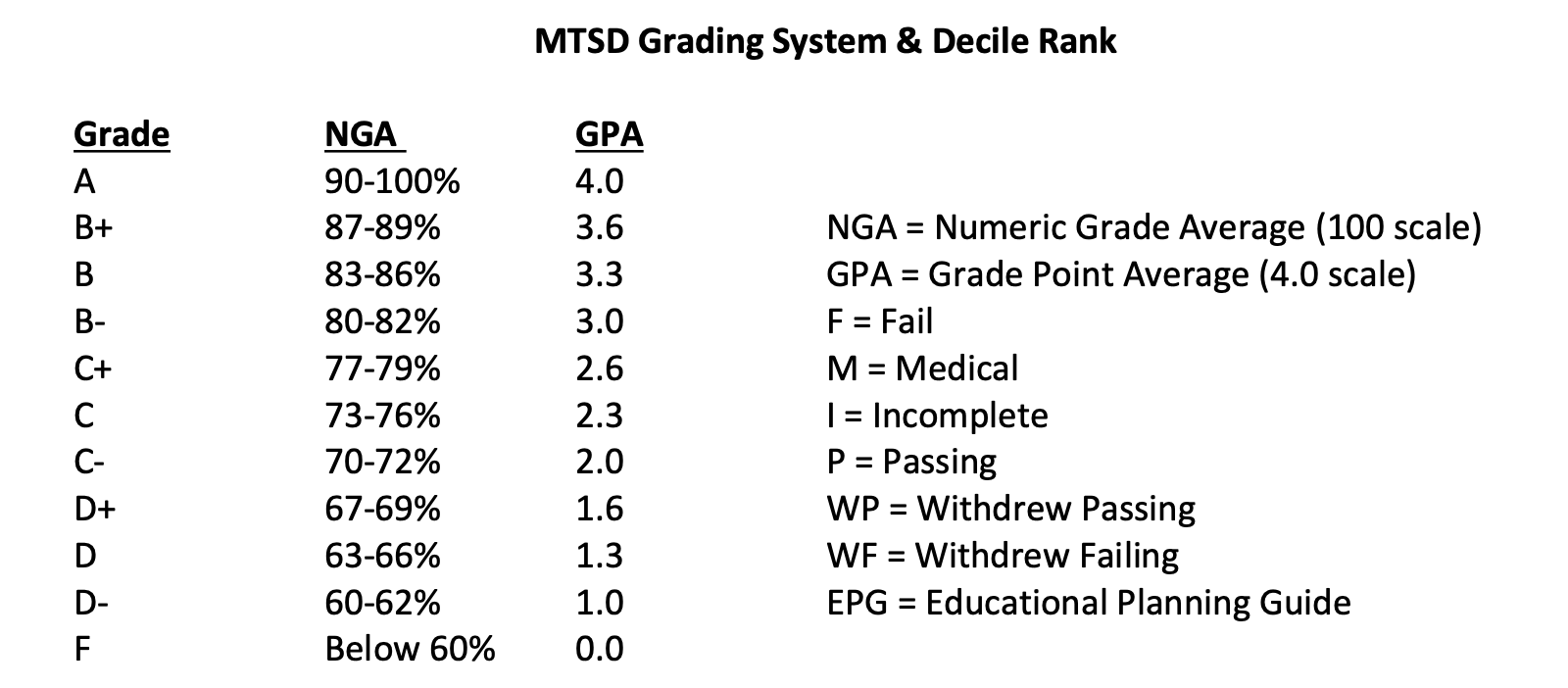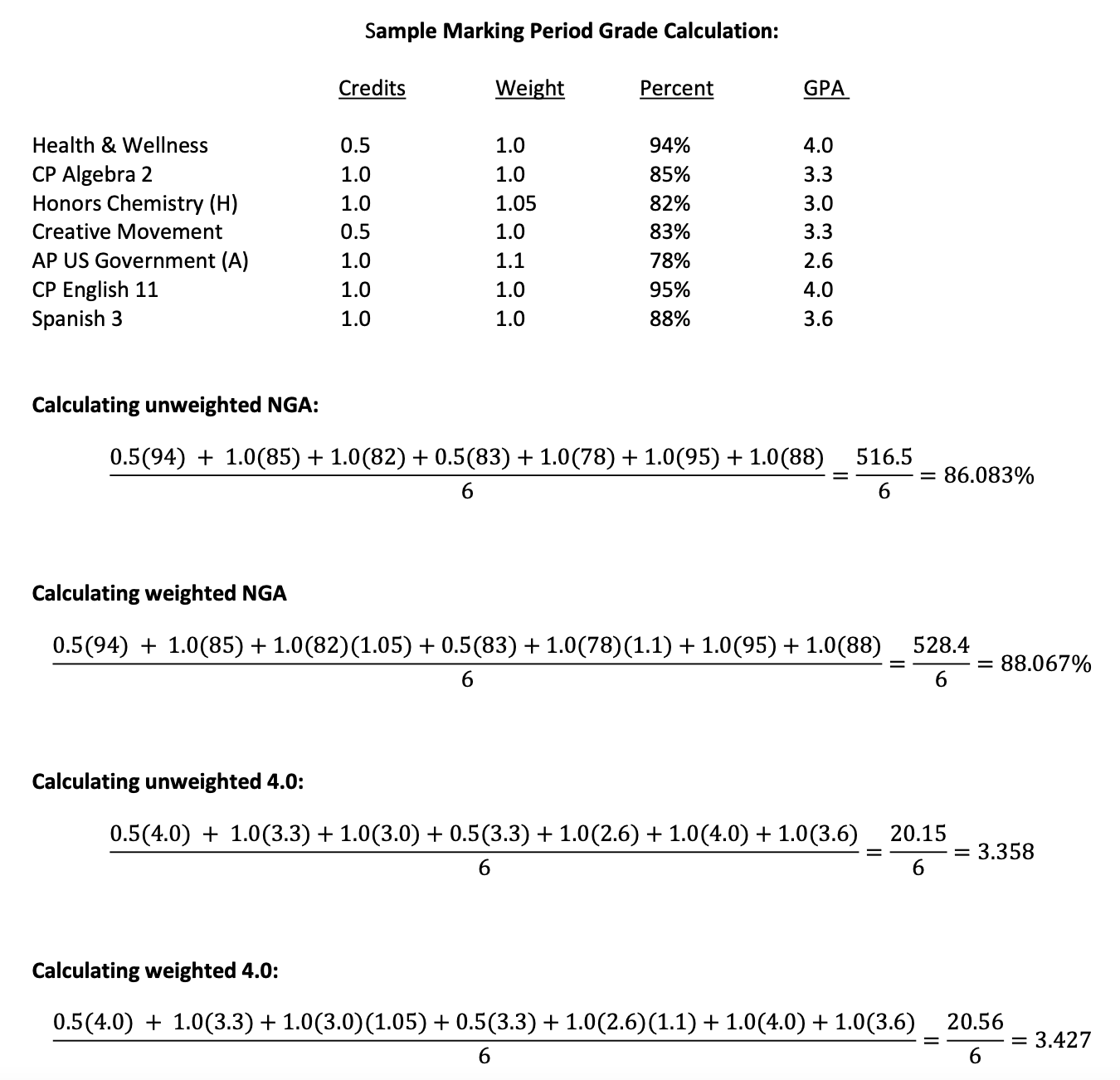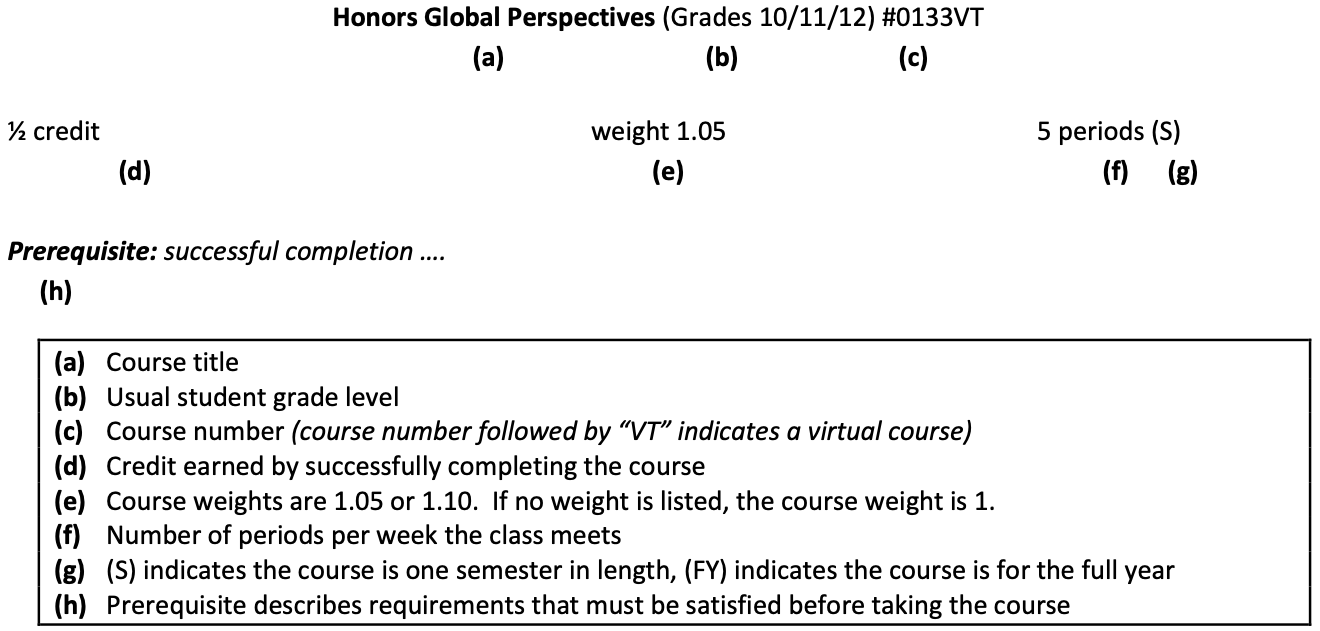grading system
Course Grades: Marking Period, Semester, and Course
Students earn numerical grades. In each course, the students earn a grade ranging from 0 to 100%. Letter grades are not officially utilized as part of the Manheim Township Grading System. Students’ marking period grades are based upon the grading system utilized by individual teachers. These systems are at the teacher discretion and are announced at the beginning of the course.
Students’ semester grades are a weighted average of their marking period grades and their midterm/final exam grade. The grade can be calculated using the following formula:
-For courses with a midterm or final exam: 0.475 x Marking Period 1 + 0.475 x Marking Period 2 + 0.05 x Midterm/Final Exam
-For courses without a midterm or final exam: 0.5 x Marking Period 1 + 0.5 x Marking Period 2
Students’ course grades for year-long courses are the average of the 1st semester and 2nd semester grades. For semester-long courses, the course grade is equal to the semester grade.
IMPORTANT NOTE: For the semester and year-long calculations, only values rounded to the nearest whole number are used in the calculation and reported. Decimal parts are not utilized or reported.
Final/Midterm Exams
As part of their course grades, students take midterm and final examinations in English, social studies, science, and mathematics courses.
Honor Roll
There is a First Honor Roll and a regular Honor Roll. To be eligible for the First Honor Roll a student must have a marking period weighted NGA of 93% with no grade lower than an 80% in any subject. The regular Honor Roll is comprised of students with a marking period NGA of 83% with no grade lower than a 70% in any subject. A student must be attempting four credits (or the equivalent of five courses) to be eligible for either Honor Roll.
Grade Level Status: Freshman, Sophomore, Junior, and Senior
The classification of sophomore is given after a student has completed 4.5 credits of work. The classification for a junior is given after a student has completed 11 credits of work, and the classification of senior is given upon the completion of 16 credits of work. The students’ grade levels generally change at the conclusion of school year, but students can be promoted at mid-year if, through passing semester courses, their number of credits reaches the next classification. Credits are not awarded for coursework completed prior to the end of grade 8. To determine the credit value of a course, refer to the course description section printed in this guide.
Dropping a Course
Students who drop a course [See Schedule Changes], prior to the end of the 1st marking period (1st semester and year-long courses), or prior to the end of the 3rd marking period (2nd semester courses) will have the course removed from their record. Courses dropped after that time will remain as part of the record and reflect a WP (Withdrew Passing) or WF (Withdrew Failing) based on their classroom performance to that time.
Importance of Attendance and Classroom Behavior
While student attendance and classroom behavior will not be directly factored into a student’s grade, good attendance and behavior is an important factor in successfully mastering a course. When absent, it is the student’s responsibility to see the instructor and make arrangements for completing the work missed in a timely fashion. Failure to do so may result in a failing grade for any work missed.
Course Level Changes
Students changing course levels (i.e., Honors to College Prep) [See Schedule Changes] will have their grades from the earlier course transfer along to their new course placement. Students who drop a level will take their UNWEIGHTED grade with them to the new class.
Repeating a Course
Students may repeat a course for grade improvement or to earn credit. Students doing so will retain both the “new” course grade and the original course grade as part of their permanent record. All attempted credits are documented and calculated in the NGA; however, only one credit will count toward meeting graduation requirements.
Senior Pass/Not Pass Option
Seniors who have successfully completed the required courses through grade 11 will be able to take one course with a Pass (P)/Not Pass (NP) evaluation. Seniors must confer with and receive permission from their school counselor. Students must also obtain a signature from their class teacher. The student’s school counselor will submit the form to the principal for signature and final approval. The Pass/Not Pass form (available in the School Counseling Office) must be completed by the last day of the first marking period for firs semester and full-year courses, and the last day of the third marking period for second semester courses. The same deadlines apply for rescinding a request.
Questions & Answers About the Manheim Township High School Transcript
1. What do colleges/universities consider when evaluating student academic records as part of the application review process?
Postsecondary institutions consider variations among secondary schools when evaluating student academic records in the application review process. Much of this information is garnered from the school’s profile, which provides information on student demographics, curriculum, grading systems, transcript format, and school resources. The National Association for College Admissions Counseling (NACAC) provides best practices and guidelines for districts to develop their school profiles. This document provides contextual information that admissions professionals use in application review to determine the rigor of the curriculum a student is taking and to understand where a student falls within the context of their High School. Many colleges and universities recalculate cumulative grades, given that school districts throughout the state and nation differ in their grading scales.
2. What is the MT High School Profile that is shared with colleges and universities?
This document (located on our high school website and linked HERE) shares information about our high school with colleges and universities so that they have an understanding of how we evaluate and endorse students’ academic performance.
3. How do varying course weightings impact our students when compared to students from other high schools across the country?
The use of a 4.0 scale and 100 point scale (Numeric Grade Average [NGA] scale), combined with our weighting system, supports our students who are seeking to continue their education beyond Manheim Township School District. Final marks in all credit courses are reported on our report cards and transcripts and more weight is placed on higher level coursework. For a full list of our weighted courses, please consult the Educational Planning Guide (EPG).
4. Why do we include the 4.0 scale and 100 point scale (NGA) on the high school transcript?
When asked, the MTHS School Counseling Department reports student grades on the 100 point scale. We provide a conversion of the 4.0 scale in order to share a comprehensive overview of student academic achievement.
5. Is there a connection between the 4.0 scale and the 100 point scale (NGA) or are they different scales?
The 4.0 scale and 100 point scale (NGA) are different scales and do not correlate. Please see information below for more information about these scales.
6. Does MTSD confer with colleges/universities regarding the grading scales?
We routinely communicate with various colleges including (but not limited to): Harrisburg Area Community College, Thaddeus Stevens, Franklin & Marshall, Gettysburg College, John Hopkins University, Columbia University, University of Pennsylvania, and Penn State University. These institutions provide guidance with regard to our grading systems, as well as understanding about the college application and admissions process. MTSD also follows guidelines and best practices shared by the National Association for College Admissions Counseling (NACAC) and Pennsylvania Association for College Admissions Counseling (PACAC).
7. Do MTSD’s grading scales encourage students to take rigorous course offerings?
Yes, this is why MTSD places weight on higher-level coursework. Weighted grades provide an incentive for students to challenge themselves academically. For a full list of our weighted courses, please consult the Educational Planning Guide.

- The school year consists of two semesters: four marking periods of approximately 45 days each. There are seven class periods each day.
- A student’s numeric grade average and decile rank reflect the academic achievement of the student’s final course grades and are computed cumulatively on the basis of a 100 percent scale at the conclusion of each semester. Midterms and Finals are administered in designated core content areas. These assessments, if administered, are each weighted 2.5% of the student’s final grade.
- Pass/Not Pass: Manheim Township High School offers dual enrollment with local colleges where students take coursework alongside college students; taught by college faculty. These courses are designated on the transcript as College Dual Enrollment along with the subject area and receive a grade of Pass/Not Pass. Students that meet certain eligibility requirements may also apply to take one course as Pass/Not Pass during their Senior year. Pass grades are not included in the calculation of NGA, but do count for graduation credit. For NCAA purposes, please speak with your school counselor and reference the Educational Planning Guide before electing to take a course Pass/Not Pass.
- Students who take higher level coursework receive additional weighting in final grade calculations. For a full list of our weighted courses, please consult the Educational Planning Guide.
- Students can access an unofficial copy of their transcript on the Community Portal. The unofficial transcript allows students to review their academic progress and is updated once grades are posted at the end of each semester. Official transcripts can be requested and sent by the MTHS School Counseling Office.

Please note: While student report cards will show the current marking period NGA, the cumulative NGA will only be recalculated at the end of each semester.
For additional information and resources on the College Admissions process and Post-Secondary Planning Resources, please refer to the MTHS Counseling Office website or reach out to your student’s counselor. Additionally, many resources can be found on the “Class of” Schoology courses.
How to determine what classes to select
- Carefully study the entire planning guide in order to take full advantage of the variety and flexibility of offerings. Refer to your grade level’s suggested guidelines for grade-specific guidance on requirements and recommended courses.
- Identify the courses you wish to take in your core areas (English, mathematics, science, social studies, and world languages) and determine if you meet the prerequisites. Your current teacher can give you advice regarding what course(s) you may want to elect.
- Identify other courses you may need to take in the upcoming year to satisfy specific graduation requirements (i.e., Financial Literacy, Health, and Physical Education) - and choose your physical education course.
- 9th, 10th, and 11th grade students must schedule the time equivalent of six major subjects (credits) per year [12th grade students must schedule five].
- The maximum number of credits students may select is seven. Students will only be permitted to take more than seven credits if it is necessary to stay on track to graduate. Students wishing to take more than seven credits must meet with their counselor to select their courses.
- After choosing your core courses and other required courses, identify elective courses that interest you to complete your schedule. You must also identify alternate choices. Having a “back-up” alternate selection for every elective course will help ensure that you have a complete schedule if courses become full or your primary choices conflict with one another.
- Ask questions. Your fellow students (particularly those older than you), your parents, your teachers and your counselor are all great sources of information.
HOW TO SCHEDULE YOUR COURSE SELECTIONS
Once you have identified the courses you wish to take, you’ll need to enter your selections via the community portal. If you do not have a community portal account, you’ll need to obtain one prior to being able to schedule. [Students who do not obtain a community portal account will be able to make their course selections after the online selection ends.]
Detailed information on how to select your courses is provided in the High School portion of the district web site (www.mtwp.net) under Course Selection.
COURSE OFFERINGS & ALTERNATE SELECTIONS
The listing of a specific course in this planning guide does not guarantee that it will be taught each school year. Administration determines whether or not a course will be offered based upon the total course enrollment, the type of course involved, and available staffing. Even if a course is offered, students are not guaranteed enrollment. Students may have conflicts in their schedule or the capacity of a course may be reached. Consequently, it is very important that students select alternate choices to maximize the chance that they will have a complete schedule.
schedule changes
Students must carry at least six credits each school year. Any changes to student schedules must maintain a minimum of six credits. [Exception: Seniors must carry at least five credits.]
- Students complete their initial selections via the community portal. After course selection is closed on the portal, all changes will need to be requested through the school counseling office.
-
The drop/add period will be the last two weeks of the first marking period.
Requests to change schedules in an effort to have certain teachers or to have certain classes/lunch periods will not be honored. Exceptions to this rule will only be made under circumstances where a student previously had the teacher and was unsuccessful in the class (a 70% or below), or the student is scheduled to have the same teacher for a third year.
Changes Once School Begins:
- For year-long courses, students may drop a course up until the end of the 1st marking period, as long as the minimum credit requirement is met; the course will be removed from the students’ academic record. Students may drop a course during the 2nd or 3rd marking period, as long as the minimum credit requirement is met; however, the course will remain on their permanent record with a grade of WP (Withdrew Passing) or WF (Withdrew Failing) based upon their performance to that point. Students may not drop a year-long course during the 4th Marking Period.
- For semester courses, students may drop a course up until the end of the 1st or 3rd marking period, as long as the minimum credit requirement is met; the course will be removed from the students’ academic record. Students may not drop a semester course during the 2nd or 4th Marking Period.
- There will be an additional add period for students to replace a study hall during second semester with an open seat in an elective course that runs during the same period. Students will be able to make this request via a google form that will be available the last two weeks of the first marking period only. The elective requested must be offered during the same period in which the student has a study hall; no other courses can be adjusted during this time. Health, PE, and PFL courses are only available to seniors in needing these courses to fulfill requirements for graduation. Communication regarding any changes will be sent to the student’s school email account.
Students may request a level change (Level 1/College Prep/Honors/AP) through their counselor. Level changes will not be considered until the midpoint of the 1st marking period of the year or semester. These changes must be completed by the end of the 1st marking period for year-long and 1st semester courses, and the end of the 3rd marking period for 2nd semester courses. The student’s grade for the 1st MP (or the 3rd MP for 2nd semester courses) will be calculated based on the percentage of days in each class, without weighting.
suggested guidelines
Click on a file to download.
HOW TO UNDERSTAND COURSE DESCRIPTIONS
All courses are described in paragraph form. Below is an example of how to interpret the additional information associated with a course description. This information is very helpful when deciding who may take the course and the credit value assigned to each course.

The listing of a specific course in this planning guide does not guarantee that it will be taught each school year. Administration determines whether or not a course will be offered based upon the total course enrollment, the type of course involved, and available staffing. Even if a course is offered, students are not guaranteed enrollment. Students may have conflicts in their schedule or the capacity of a course may be reached. Consequently, it is very important that students select alternate choices to maximize the chance that they will have a complete schedule.
Curriculum revision is an ongoing process with students, faculty and administrators making recommendations for curriculum additions periodically. Therefore, the course offerings may be modified after this guide is published and before student schedules are generated. When possible, students will be notified of these changes so that selections can be modified. The Board of School Directors makes the final determination on the curriculum offered by the school district.
